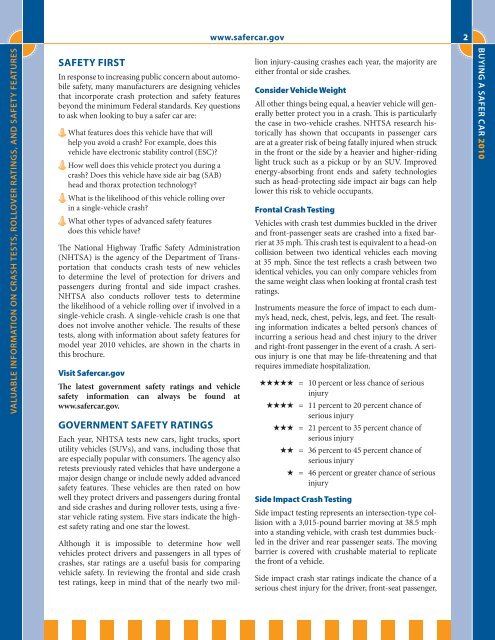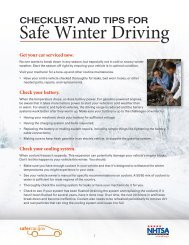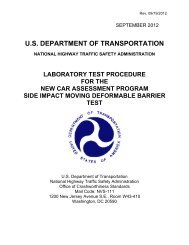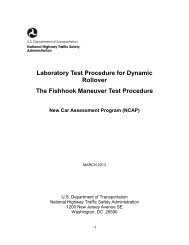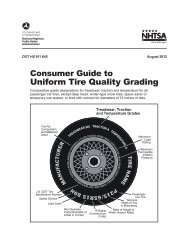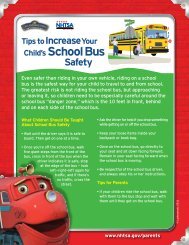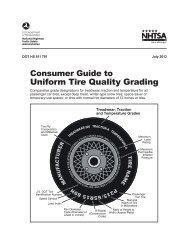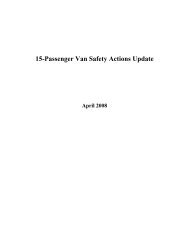Buying a Safer Car 2010: Valuable Information on ... - SaferCar.gov
Buying a Safer Car 2010: Valuable Information on ... - SaferCar.gov
Buying a Safer Car 2010: Valuable Information on ... - SaferCar.gov
You also want an ePaper? Increase the reach of your titles
YUMPU automatically turns print PDFs into web optimized ePapers that Google loves.
www.safercar.<strong>gov</strong> 2<br />
<str<strong>on</strong>g>Valuable</str<strong>on</strong>g> <str<strong>on</strong>g>Informati<strong>on</strong></str<strong>on</strong>g> <strong>on</strong> Crash Tests, Rollover Ratings, and Safety Features<br />
Safety First<br />
In resp<strong>on</strong>se to increasing public c<strong>on</strong>cern about automobile<br />
safety, many manufacturers are designing vehicles<br />
that incorporate crash protecti<strong>on</strong> and safety features<br />
bey<strong>on</strong>d the minimum Federal standards. Key questi<strong>on</strong>s<br />
to ask when looking to buy a safer car are:<br />
What features does this vehicle have that will<br />
help you avoid a crash For example, does this<br />
vehicle have electr<strong>on</strong>ic stability c<strong>on</strong>trol (ESC)<br />
How well does this vehicle protect you during a<br />
crash Does this vehicle have side air bag (SAB)<br />
head and thorax protecti<strong>on</strong> technology<br />
What is the likelihood of this vehicle rolling over<br />
in a single-vehicle crash<br />
What other types of advanced safety features<br />
does this vehicle have<br />
The Nati<strong>on</strong>al Highway Traffic Safety Administrati<strong>on</strong><br />
(NHTSA) is the agency of the Department of Transportati<strong>on</strong><br />
that c<strong>on</strong>ducts crash tests of new vehicles<br />
to determine the level of protecti<strong>on</strong> for drivers and<br />
passengers during fr<strong>on</strong>tal and side impact crashes.<br />
NHTSA also c<strong>on</strong>ducts rollover tests to determine<br />
the likelihood of a vehicle rolling over if involved in a<br />
single-vehicle crash. A single-vehicle crash is <strong>on</strong>e that<br />
does not involve another vehicle. The results of these<br />
tests, al<strong>on</strong>g with informati<strong>on</strong> about safety features for<br />
model year <str<strong>on</strong>g>2010</str<strong>on</strong>g> vehicles, are shown in the charts in<br />
this brochure.<br />
Visit <str<strong>on</strong>g>Safer</str<strong>on</strong>g>car.<strong>gov</strong><br />
The latest <strong>gov</strong>ernment safety ratings and vehicle<br />
safety informati<strong>on</strong> can always be found at<br />
www. safercar.<strong>gov</strong>.<br />
Government Safety RATINGS<br />
Each year, NHTSA tests new cars, light trucks, sport<br />
utility vehicles (SUVs), and vans, including those that<br />
are especially popular with c<strong>on</strong>sumers. The agency also<br />
retests previously rated vehicles that have underg<strong>on</strong>e a<br />
major design change or include newly added advanced<br />
safety features. These vehicles are then rated <strong>on</strong> how<br />
well they protect drivers and passengers during fr<strong>on</strong>tal<br />
and side crashes and during rollover tests, using a fivestar<br />
vehicle rating system. Five stars indicate the highest<br />
safety rating and <strong>on</strong>e star the lowest.<br />
Although it is impossible to determine how well<br />
vehicles protect drivers and passengers in all types of<br />
crashes, star ratings are a useful basis for comparing<br />
vehicle safety. In reviewing the fr<strong>on</strong>tal and side crash<br />
test ratings, keep in mind that of the nearly two milli<strong>on</strong><br />
injury-causing crashes each year, the majority are<br />
either fr<strong>on</strong>tal or side crashes.<br />
C<strong>on</strong>sider Vehicle Weight<br />
All other things being equal, a heavier vehicle will generally<br />
better protect you in a crash. This is particularly<br />
the case in two-vehicle crashes. NHTSA research historically<br />
has shown that occupants in passenger cars<br />
are at a greater risk of being fatally injured when struck<br />
in the fr<strong>on</strong>t or the side by a heavier and higher-riding<br />
light truck such as a pickup or by an SUV. Improved<br />
energy-absorbing fr<strong>on</strong>t ends and safety technologies<br />
such as head-protecting side impact air bags can help<br />
lower this risk to vehicle occupants.<br />
Fr<strong>on</strong>tal Crash Testing<br />
Vehicles with crash test dummies buckled in the driver<br />
and fr<strong>on</strong>t-passenger seats are crashed into a fixed barrier<br />
at 35 mph. This crash test is equivalent to a head-<strong>on</strong><br />
collisi<strong>on</strong> between two identical vehicles each moving<br />
at 35 mph. Since the test reflects a crash between two<br />
identical vehicles, you can <strong>on</strong>ly compare vehicles from<br />
the same weight class when looking at fr<strong>on</strong>tal crash test<br />
ratings.<br />
Instruments measure the force of impact to each dummy’s<br />
head, neck, chest, pelvis, legs, and feet. The resulting<br />
informati<strong>on</strong> indicates a belted pers<strong>on</strong>’s chances of<br />
incurring a serious head and chest injury to the driver<br />
and right-fr<strong>on</strong>t passenger in the event of a crash. A serious<br />
injury is <strong>on</strong>e that may be life-threatening and that<br />
requires immediate hospitalizati<strong>on</strong>.<br />
★★★★★ = 10 percent or less chance of serious<br />
injury<br />
★★★★ = 11 percent to 20 percent chance of<br />
serious injury<br />
★★★ = 21 percent to 35 percent chance of<br />
serious injury<br />
★★ = 36 percent to 45 percent chance of<br />
serious injury<br />
★ = 46 percent or greater chance of serious<br />
injury<br />
Side Impact Crash Testing<br />
Side impact testing represents an intersecti<strong>on</strong>-type collisi<strong>on</strong><br />
with a 3,015-pound barrier moving at 38.5 mph<br />
into a standing vehicle, with crash test dummies buckled<br />
in the driver and rear passenger seats. The moving<br />
barrier is covered with crushable material to replicate<br />
the fr<strong>on</strong>t of a vehicle.<br />
Side impact crash star ratings indicate the chance of a<br />
serious chest injury for the driver, fr<strong>on</strong>t-seat passenger,<br />
<str<strong>on</strong>g>Buying</str<strong>on</strong>g> A <str<strong>on</strong>g>Safer</str<strong>on</strong>g> <str<strong>on</strong>g>Car</str<strong>on</strong>g> <str<strong>on</strong>g>2010</str<strong>on</strong>g>


